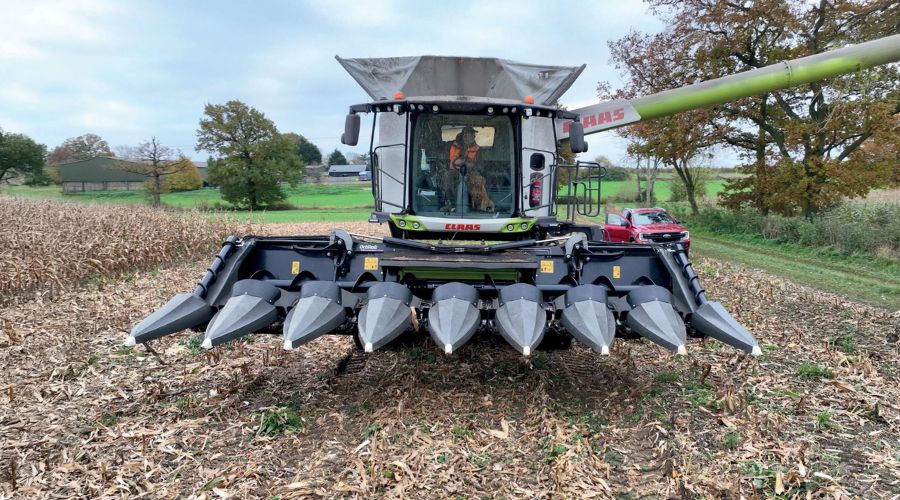Maize header gets harvest done in half the time
6th February 2025
A maize header investment paid off for Suffolk farmer James Forrest – harvest was completed faster and it reduced wear and tear on the combine. Sarah Kidby reports.

Having previously used a conventional header for grain maize harvesting, James Forrest decided to invest in a C7508 CF Corn Header from MacDon for the 2024 harvest. Unlike a conventional header, which takes on the whole crop including stalks, with the MacDon C Series, only the cob goes through to the combine, while rollers push the stalk out of the bottom to be chopped up.
Commenting on the benefits, Rob Hale, farm foreman for RH Forrest & Co said: “It’s a lot easier to feed the crop through, it speeds up harvest considerably, there’s less wear and tear on the combine compared to a conventional header – which has to take in the whole crop including stalking, and the MacDon header will pick up lodged crop better.”
He estimates the harvest took half the time with the new header. Asked if there were any improvements he would make, he said he was very happy with its operation and wouldn’t change anything.
Made in Hungary, the header is fairly new to the UK and although MacDon has been making maize headers for many years, 2024 was the first year they operated in the UK. With this in mind, MacDon area sales and product support, Simon Kirk, visited RH Forrest on the day of our visit to find out how they were getting on with the header and to get feedback on any improvements needed. But the only suggestion was to move one of the indicators to a more visible location.
Competitively priced maize header
Maize is grown as a break crop at RH Forrest, in outlying fields that are unsuitable for sugar beet. 2024 was the 4,000-acre farm’s third grain maize harvest over the past four years and completed a couple of days after our visit in mid-November.
James opted for an eight-row 75cm chopping header from MacDon, which folds up for transport, to be used with his Claas Lexion 8900 combine. The header includes the OctiRoll system, which means rollers pull the stalk down and complete the chopping and crimping all in one system, Simon explained.
The MacDon header is only the second one sold by dealer Ernest Doe’s local branch, so much of the support came directly from MacDon itself and Rob said they were very helpful – and Ernest Doe was also just down the road if they needed anything.
The header ranges from 6–16 rows and there is currently a 12-row and 16-row in the UK, Simon said. MacDon C Series Headers are designed to fit most major brand combines with an easy to install completion package, and little adjustment is needed.
Big yield potential
RH Forrest has moved to grain maize over the past four years as it’s a crop that can cope more easily with difficult weather, and there are “big yield potentials”, Rob explained. It’s a far more reliable crop now than OSR or beans, the latter of which is a ‘feast or famine’ crop, only reaping a profit in one in every five years. “This year was a good year, but the five previous years were pretty average to poor, whereas maize is a fairly durable crop. It will stick the weather well, particularly in seasons like this one,” he added.
The maize was drilled in early- to mid-May, a little late as they had to finish drilling the sugar beet first – and when they finally started on maize, they had 60mm of rain within 24 hours of drilling the first block, which not only impacted the emergence of the crop, it also delayed the drilling of the next 30ha by a fortnight. In a more average season than last year they would have been able to start harvesting in late October, which would have put them in a better position for getting a crop in behind it, Rob said.
This aside, they were lucky with the weather in the first couple of weeks of November. The crop was harvested with a moisture content of 33% and dried to 15% with first a floor dryer then a batch dryer.
Around 45ha was drilled in 2024, at a seed rate of 80,000 due to the shorter growing period, but they are looking to increase the acreage going forward on some of the contract farms further afield, Rob said. It’s hoped they will achieve 8.5–9 tonnes/ha but there is potential for 11–13t/ha if maize is drilled in good time and the weather is favourable. It had 150kg N per hectare and target margins are £1,000/ha.
Currently, James is only growing maize on his own farm, but there are plans to drill maize on contract farms next year.
